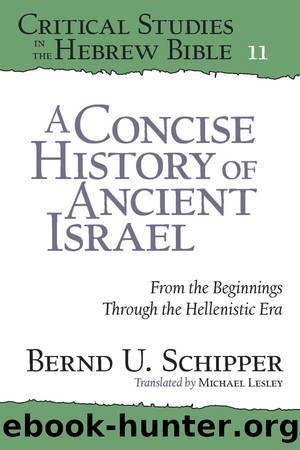A Concise History of Ancient Israel (Critical Studies in the Hebrew Bible) by Bernd U. Schipper

Author:Bernd U. Schipper [Schipper, Bernd U.]
Language: eng
Format: azw3
Publisher: Penn State University Press
Published: 2020-04-27T16:00:00+00:00
5.2 Persian Policy from 539 to 333
Neither the variety of forms of Yahwism in the fifth and fourth centuries nor the return of a group of exiles would have been possible, however, had there not been a sea change in the broader political situation. Beginning in 550, with Cyrus II, the Persian emperors built an empire worthy of the title. This empire, formed by Cambyses and Darius I through the incorporation of smaller states, stretched westward as far as the Aegean to the southern border of Egypt, and included the whole of Mesopotamia and the Iranian highlands in the east as far as the Indus valley (map 2).33
The beginning of the Persian period is generally dated to Cyrus II’s conquest of Babylon (539), which was then ruled by the last Neo-Babylonian king, Nabonidus (556–539).34 Shortly after coming to power Cyrus II (559–530) broke free of Median rule (550), and in 547–46 he extended his territory from Elam to Asia Minor. In 539 he moved on Babylon, taking advantage of the opposition of the priests of Marduk to Nabonidus, who had attempted to raise the status of Sîn (god of the moon) and Shamash (god of the sun) at the expense of the god of the city of Babylon. As Cyrus advanced, the priests of Marduk sided with him, and the city fell without a fight.
In the famous Cyrus Cylinder (COS 2.124) Cyrus celebrates the conquest of Babylon and presents himself as a loyal worshipper of the god Marduk.35 From this royal ideological text and surprisingly similar statements in the book of Isaiah (Isa 44:28; 45:1–7), Hebrew Bible scholars have assumed that the great kings of Persia were religiously tolerant and supported local holy places.36 But the religious policies of the Persians primarily served power politics and economic interests, which involved not only supporting local cults, but also containing them when necessary, which could include the destruction of their temples, as occurred in Didyma and Athens.37
The conquest of Babylon and the defeat of Nabonidus in 539 paved the way for further conquest. Though Cyrus II died in 530, in a campaign against the Massageteans in the east, his successors turned Persia into a world power. Cambyses (530–522) conquered Egypt, and Darius I (522–486) and Xerxes I (486–465) systematically organized the empire from the top down.
Shortly after Cambyses proclaimed himself pharaoh in Egypt (526, Twenty-seventh Dynasty) a rebellion broke out in Persepolis, under the leadership of a certain Gaumata, who claimed to be the lawful heir.38 Cambyses died under unknown circumstances on his way home from Egypt, while Gaumata, who by then had taken the throne, was murdered by Persian tribal royalty.39 It was in this turmoil that Darius I (522–486) became king.
A trilingual monumental inscription from Bisitun, on the ancient military road from Mesopotamia to Central Asia, gives an account of the turmoil around the throne and Darius I’s seizure of power in Elamite, Babylonian, and ancient Persian.40 Following the familiar pattern of chaos to order, the king’s claim to power
Download
This site does not store any files on its server. We only index and link to content provided by other sites. Please contact the content providers to delete copyright contents if any and email us, we'll remove relevant links or contents immediately.
| Africa | Americas |
| Arctic & Antarctica | Asia |
| Australia & Oceania | Europe |
| Middle East | Russia |
| United States | World |
| Ancient Civilizations | Military |
| Historical Study & Educational Resources |
The Daily Stoic by Holiday Ryan & Hanselman Stephen(3235)
The Fate of Rome: Climate, Disease, and the End of an Empire (The Princeton History of the Ancient World) by Kyle Harper(3007)
People of the Earth: An Introduction to World Prehistory by Dr. Brian Fagan & Nadia Durrani(2702)
Ancient Worlds by Michael Scott(2627)
Babylon's Ark by Lawrence Anthony(2622)
The Daily Stoic by Ryan Holiday & Stephen Hanselman(2465)
Foreign Devils on the Silk Road: The Search for the Lost Treasures of Central Asia by Peter Hopkirk(2434)
India's Ancient Past by R.S. Sharma(2417)
MOSES THE EGYPTIAN by Jan Assmann(2374)
The Complete Dead Sea Scrolls in English (7th Edition) (Penguin Classics) by Geza Vermes(2237)
Lost Technologies of Ancient Egypt by Christopher Dunn(2195)
The Earth Chronicles Handbook by Zecharia Sitchin(2180)
24 Hours in Ancient Rome by Philip Matyszak(2051)
Alexander the Great by Philip Freeman(2034)
Aztec by Gary Jennings(1977)
The Nine Waves of Creation by Carl Johan Calleman(1884)
Curse Tablets and Binding Spells from the Ancient World by Gager John G.;(1838)
Before Atlantis by Frank Joseph(1814)
Earthmare: The Lost Book of Wars by Cergat(1792)
